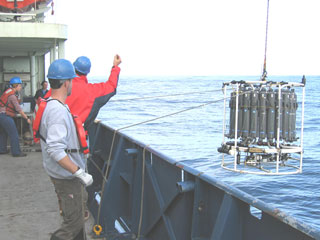
What is the relationship between Climate Change and HABs?
Climate is always changing, whether from longer time-scale (such as glacial cycles) or shorter time-scale (such as El Niño-Southern Oscillation) events. However, in addition to these natural changes, increased carbon dioxide (CO2) in the atmosphere as a result of human activities, like the burning of fossil fuels, introduces another layer of climate variability that will likely impact HABs.
Climate change has the potential to affect the occurrence and severity of HABs because the growth, toxicity, and geographic distributions of HAB species (like all phytoplankton) are impacted by environmental variability. Additionally, the susceptibility of shellfish, fish, and marine animals to the impacts of HABs can be exacerbated by other stressors that are also caused by climate changes.
Recent data shows that unusual or unprecedented algal blooms have been linked to climate anomalies (e.g., Belgrano et al. 1999, Skjodal and Dundas 1991, Cloern et al. 2006, Moore et al. 2009). Further, rising sea surface temperatures have been associated with increases in dinoflagellates (many HAB species are dinoflagellates) in the North Atlantic, North Sea, and Baltic Sea and with an earlier appearance of dinoflagellates in the seasonal cycle (reviewed by Dale et al. 2006). Evidence also indicates that climate warming may benefit some species of harmful cyanobacteria (both freshwater and marine) by providing more optimal conditions for their growth (reviewed by Paerl and Huisman 2008 and 2009). Increasing temperature and CO2 either alone or in combination with nutrient availability may determine the growth and relative abundance of HAB species (Fu et al. 2008). Historical evidence from long term phytoplankton monitoring data and fossil records suggests that future climate warming could impact HABs through the alteration of their geographic range and shifts toward relatively more and earlier blooms (reviewed by Dale et al. 2006).

As part of its overall goal of understanding and predicting HAB events and their impacts in an ecosystem context, CSCOR’s Ecology and Oceanography of Harmful Algal Blooms (ECOHAB), Monitoring and Event Response for Harmful Algal Blooms (MERHAB), and Prevention, Control, and Mitigation of Harmful Algal Blooms (PCM HABs) Research Programs will support projects addressing the impacts of climate change on HABs in estuarine, coastal, and Great Lakes ecosystems. Climate change will largely manifest as regional changes, which closely aligns with CSCOR’s regional approach to its research.

Coastal and marine ecosystems, including local economies, are already vulnerable to the impact of HABs, so it is important to understand how future changes to climate may influence HAB occurrence and severity (Moore et al. 2008). This knowledge will be critical to the development of adaptive strategies for management of HABs.
Belgrano A, Lindahl M, Hernroth B. 1999. North Atlantic oscillation, primary productivity, and toxic phytoplankton in the Gullmar Fjord, Sweden (1985-1996). Proc. R Soc Lond, ser B 266:425-430.
Cloern JE, Schraga TS, Lopez CB, Knowles N, Labiosa RG, Dugdale R. 2005. Climate anomalies generate an exceptional dinoflagellate bloom in San Francisco Bay. Geophysical Research Letters, v. 32, L14608, doi: 10.1029/2005GL023321.
Dale B, Edwards M, Reid PC. 2006. Climate Change and Harmful Algal Blooms. In: Graneli E and Turner J. Ecology of Harmful Algae. Ecological Studies Vol 189. Dordrecht, The Netherlands: Springer-Verlag, pp367-378.
Fu FX, Zhang Y, Warner ME, Feng Y, Sun J, Hutchins DA. 2008. A comparison of future increased CO_2 and temperature effects on sympatric Heterosigma akashiwo and Prorocentrum minimum. Harmful Algae 7 (1): 76-90.
Moore SK, Trainer VL, Mantua NJ, Parker MS, Laws EA, Backer LC, Fleming LE. 2008 Impacts of climate variability and future climate change on harmful algal blooms and human health. Environmental Health 7(Suppl 2): S4.
Moore SK, Mantua NJ, Hickey BM, Trainer VL. 2009. Recent trends in paralytic shellfish toxins in Puget Sound, relationships to climate, and capacity for prediction of toxic events. Harmful Algae 8:463-477.
Skjoldal HR, Dundas I. 1991. The Chrysochromulina polylepis bloom in the Skagerrak and Kattegat in May0June 1988: environmental conditions, possible causes, and effects. ICES Coop Res Rep 175:1-59.
Paerl HW, Huisman J. 2008. Blooms like it hot. Science 320:57-58.
Paerl HW, Huisman J. 2009. Climate change: a catalyst for global expansion of harmful cyanobacterial blooms. Environmental Microbiology Reports 1(1): 27–37.

Alexandrium sp. from the ECOHAB Pacific Northwest September 2004 Cruise. Photo by Brian Bill, NOAA.

Deployment of equipment to measure water parameters, ECOHAB Pacific Northwest September 2004 Cruise. Photo by NOAA.